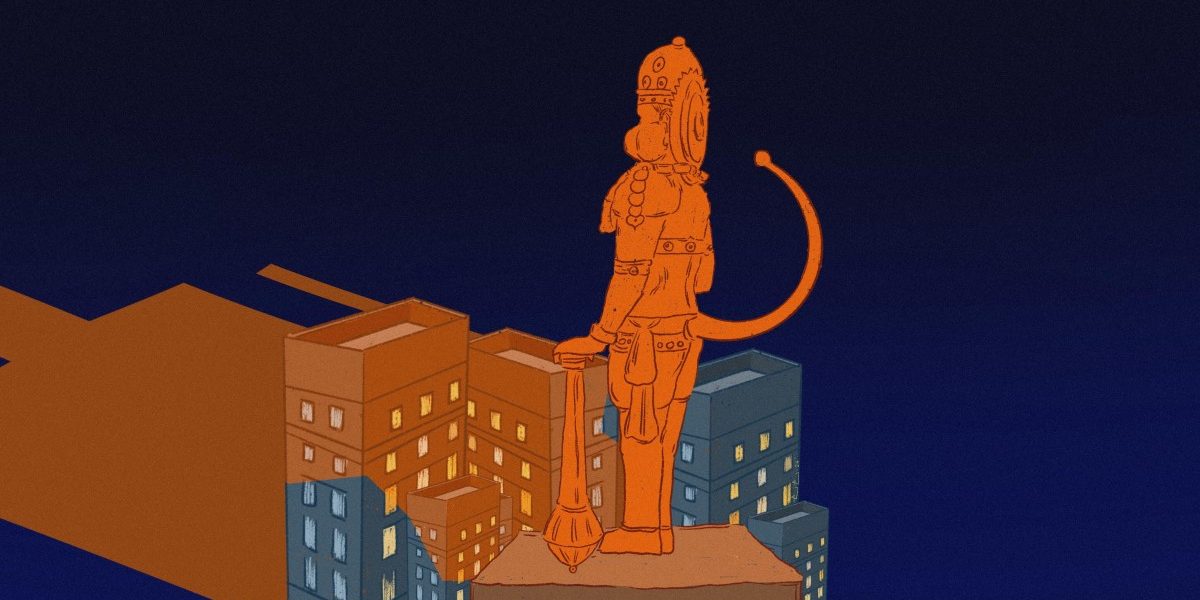Street lamps flickered under the cold nip of the night as the residents of an increasingly urbanised upper-middle-class apartment complex of Gulshan Vivante in Noida’s Sector 137 were busy concocting dreams.
What kept them tucked under their blankets having no fear of the unknown was their faith in God and her indisputable protection.
The area is blissfully silent until the main gate opens with a seemingly unpleasant creek, and, probably, there walks in a bunch of individuals carrying a mid-sized statue of the Hindu deity Hanuman, treading with secrecy in order not to shatter the idol of their all-loving God, and open people’s eyes in the process.
Unknown to any of the inhabitants, the statue is placed facing the tallest tower within the residential complex, as a pedestal is cemented to the ground that gives the saffron-clad idol its foundation.
The city is indeed sleeping, despite the growing tensions of the ongoing Lok Sabha elections being palpably present.
A temple emerges
As dawn breaks, a pandit can be seen performing an aarti of the newly placed idol, whilst people flock to the ground floor to wonder what ‘miracle’ the full moon of the night performed for the Divine to spawn on his own. Others began looking for the culprit who planned this spectacle deceitfully in the name of God.
Saturday morning – a time when the phone is spared of notifications from conscious adults discussing office work – is spammed with discussions surrounding this event. All residents who rightfully had paid for their flats in the tallest building in the sector felt betrayed for they believed they lost their autonomy to control what goes on around the estate they own.
Pictures were being clicked and forwarded to multiple WhatsApp groups, while my journalist father rang his colleagues to report the incident.
Every resident was visibly agitated because of what had transpired the previous night. Any attachment, structure or idol to be placed within the residential complex depended on a majority vote and a discussion with the apartment owners’ association.
Time and again people reiterated how the idol was placed without a proper consensus, and while they desired a foolproof discussion in the banquet hall, no one was ready to take firm action, i.e., have the idol removed from the apartment complex.

Given the current political climate, people fear communal sentiments clouding others’ sense of judgment. While some people raised slogans of ‘Jai Shri Ram!’ and ‘Jai Bajrangbali!’ in the chats they sent around, others emphasised the importance of not removing the idol because religious sentiments may be violated!
What, however, commenced under the veil of the night is an act of conflating religion and nationalism, asserting that the whole residential complex was the mecca of Hindus, completely barring other religions from standing in queue for worship.
The place where the idol now stands was an area where the old and the children spent most of their time for recreation. It has not only barred people from using the space the way they desire to do so, but has eliminated the scope for an alternative ideology.
Sooner or later, people will demand the placement of other favoured Gods for worship. The complex, which seemingly prides itself on giving its residents ‘peace’ and happiness, is going to echo with kirtans, bhajans and possibly the expression of loud communal comments that were earlier mostly confined to the private sphere.
Non-residents will begin demanding entry into the society and impinge on residential space to satisfy their pursuit of spirituality.
The morning after
Children were found with folded hands and bowed heads in front of the idol post its ceremonial consecration.
What message are we giving out to our 7-8-year-olds whose innocence knows no bounds?
Is this breach of community trust justified?
Should religions other than Hinduism, practiced by a majority on the Indian subcontinent, be granted zero space and visibility here? Is the use of public space paying no heed to other people’s sentiments and sensibilities a solution to our quest for jingoism and expression of religious fervour?
Lord Vishnu announced that he will be returning to Earth during Kalyug to eradicate those who embody the worst in humanity and taint its purity. The placement of this idol poses a reflective question to those who surround it. It provokes us to visualise the course of socio-cultural changes and the role religion plays in shaping the community psyche.
The installation of an idol of a Hindu deity in this fashion is the beginning of pushing people to occupy polarities and the bifurcation of a plural and composite nation’s people in the name of religion.
I will go as far as to say that what happened here is no different than what happened in Ayodhya in 1948 and then 1992.
I have a question at the end of this incident. Given that all Indian citizens can express our free will, and do so openly, would it have been tolerated if a church or a mosque had been constructed in the apartment complex? Would that too have fallen prey to a demolition?
Sometimes, goings-on in a small residential area can showcase larger things happening in the country outside. This must be a wake up call for all of us to pull back from the brink. India belongs to all of us. No one and no one’s God can stand taller than everyone else’s.
The author is an undergraduate student of sociology from Sri Venkateswara College, Delhi University.
Courtesy: The Wire

